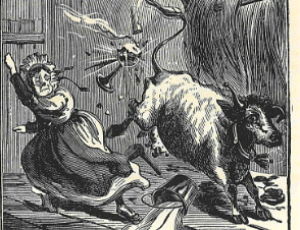Humans love to explore ancient mysteries and assign blame. After all, people are still searching for Jack the Ripper, Amelia Earhart and Judge Crater. Therefore, librarians are sometimes asked the name of Mrs. O’Leary’s cow that started the Great Chicago Fire of 1871. Thereupon lies the mystery.
Everyone knows the words to the song: “A hot time in the old town tonight...,” about the Great Chicago Fire of 1871. (In case you don’t have the melody stuck in your head, check out the Library of Congress’ audio stream of a 1904 recording.)
Although the scene of the crime was clearly proven to be the cow’s shed, guilt is not so easily established. To start with, the cow may have had accomplices. A little-mentioned fact is that the shed contained six cows, a horse and likely dogs, chickens, cats and rats.The supposedly guilty cow was never identified (although suspiciously, only one survived.) Notable also was that the surviving cow was never prosecuted or even interrogated. However, Mrs. O’Leary was persecuted for the rest of her life.
The media was quick to cast blame. According to Frank Leslie’s Illustrated (available in Special Collections), published 20 days after the fire, the most likely suspect was Mrs. O’Leary herself. “On Sunday night, she took the lamp in her hand, and went out to the barn. Wishing to obtain salt from the house, she set the lamp down to go after it. During her absence the lamp was overturned.”
The Board of Police and Fire Commissioners performed an official investigation. The hearings, which called 50 witnesses, were published by A.T. Andreas in the History of Chicago, volume II. Just 13 years after the fire, Andreas notes that “cause of the fire is now a mystery, and must ever remain so.”
Andreas puts forth four theories:
- Mrs. O’Leary visited her cows after dark, carrying a kerosene lamp, which was kicked over by the historic cow, setting fire to the surrounding rubbish;
- One of O’Leary’s neighbors, the McLaughlins, was hosting a party and surreptitiously visited the barn, also with a lighted lamp, to get milk from a cow for “oyster stew”;
- Some boys were “enjoying a moment of stolen pleasure in the barn, with pipes or cigars, and carelessly let fire fall among the inflammable substances on the floor”;
- The fire was deliberately set by an incendiary.
Andreas noted the police and fire investigations were inconclusive. He noted that the entire O’Leary household “proved” to be asleep at the time the fire started. You can find excerpts from the hearings, especially key witnesses like Catherine O’Leary, in many places. Edited transcripts are in The Great Chicago Fire and the Myth of Mrs. O'Leary's Cow.
If it wasn’t the cow, who was it?
Other investigators have named as perpetrators:
- Spontaneous combustion
- A spark from a chimney
- Anarchist arsonists
- A careless smoker
- Gamblers shooting dice,
- A drunken Dennis “Peg-leg” Sullivan, wanting milk for his whiskey, broke into the cowshed.
Not all alleged perpetrators were of earthly origin. History of the Chicago Police notes that the fire was immediately said to be divine retribution for Chicago’s wicked ways. Ragnarok, Or, The Age of Fire and Gravel published in 1882 attributes the fire to a shower of meteorites. On April 1, 2012 the Chicago History Museum published a picture of a UFO hovering over the fire.
Even the idea that a broken lamp found near the origin was the spark could be contested in modern arson investigations. One hundred and twenty-six years later, the Chicago City Council decided to weigh in. In 1997, they passed a resolution exonerating Catherine O’Leary and the cow. The City Council did not name an alternate culprit.
Be your own detective by exploring the many books about the Chicago fire.




Add a comment to: Whodunit? The Mystery of Mrs. O’Leary’s Cow